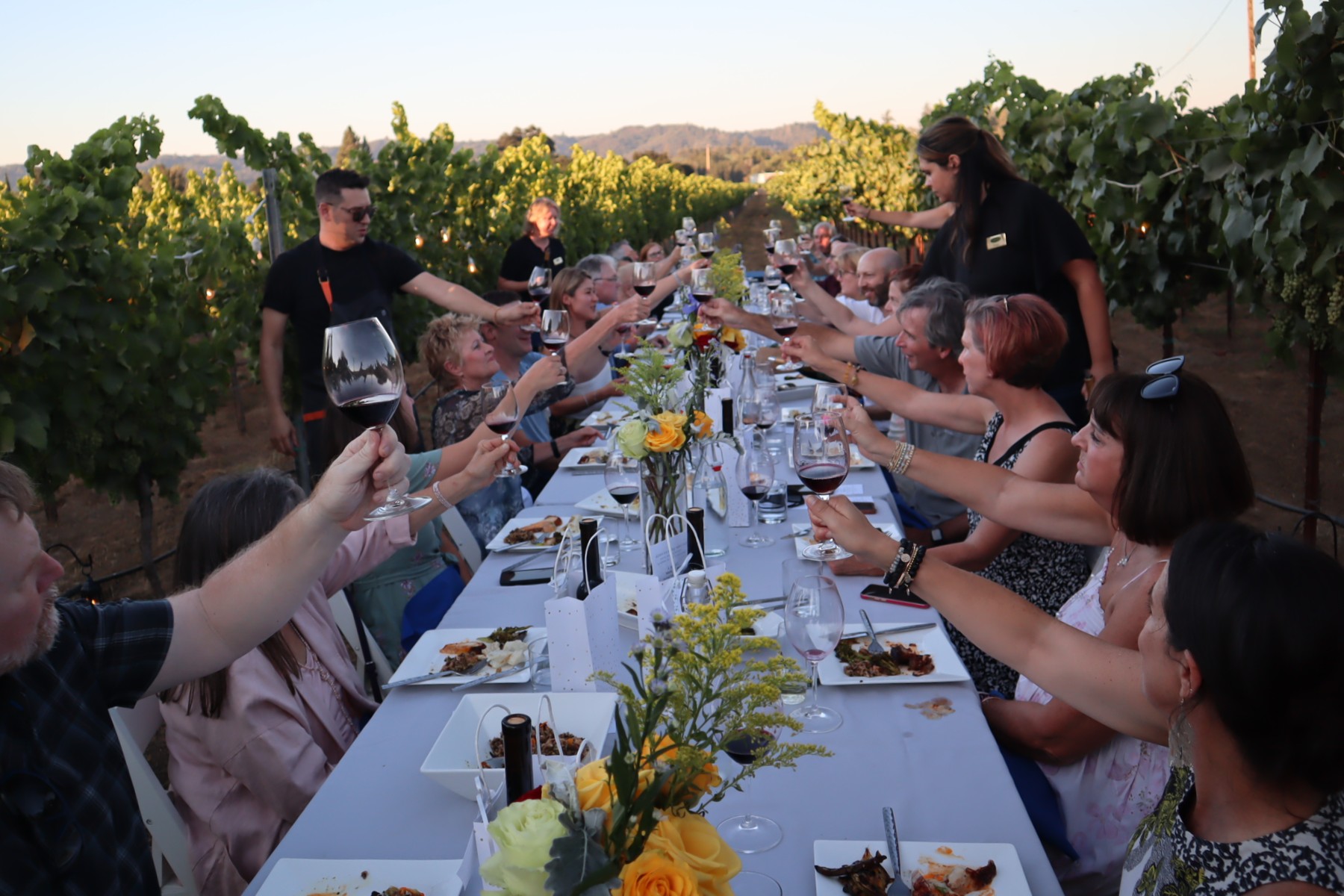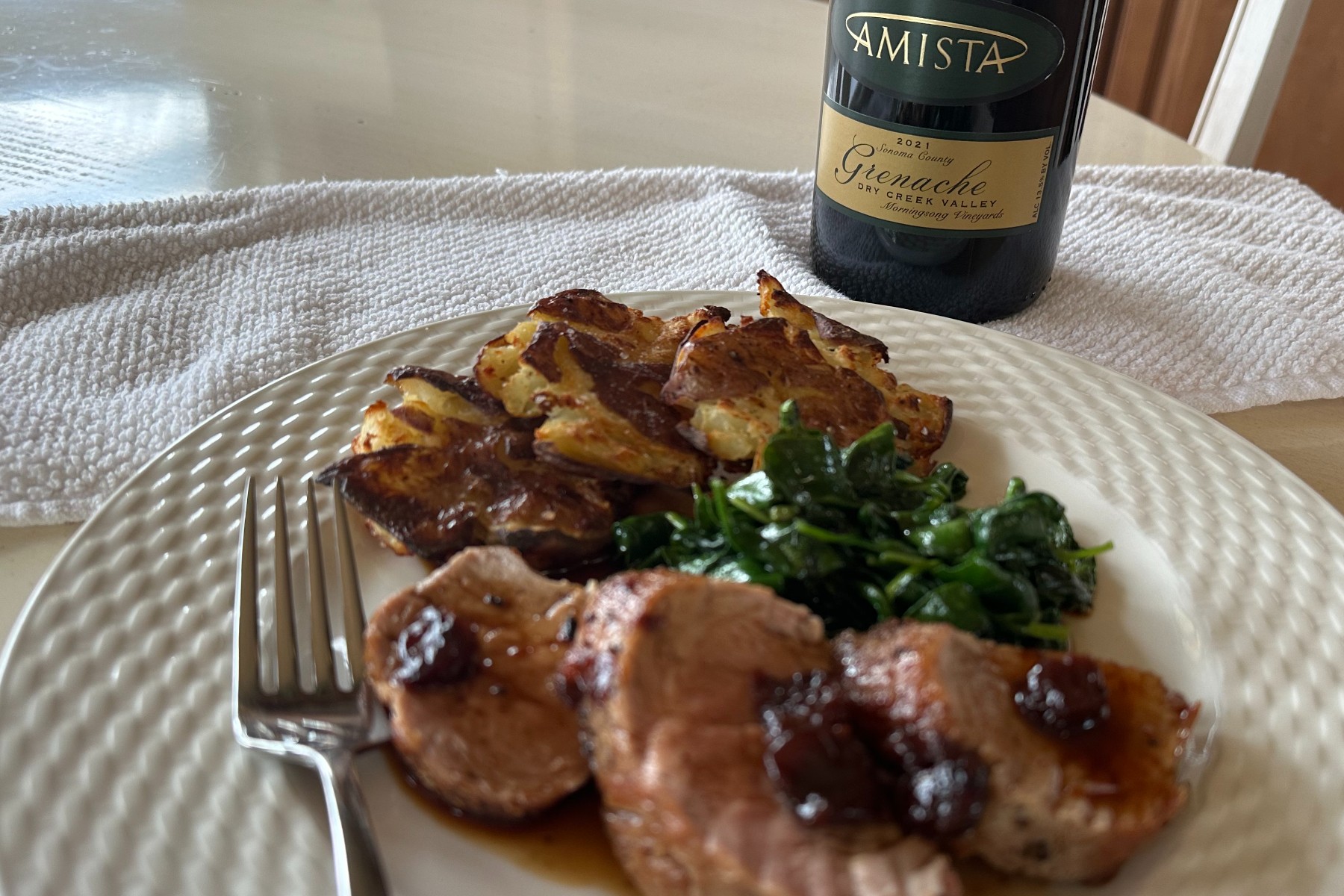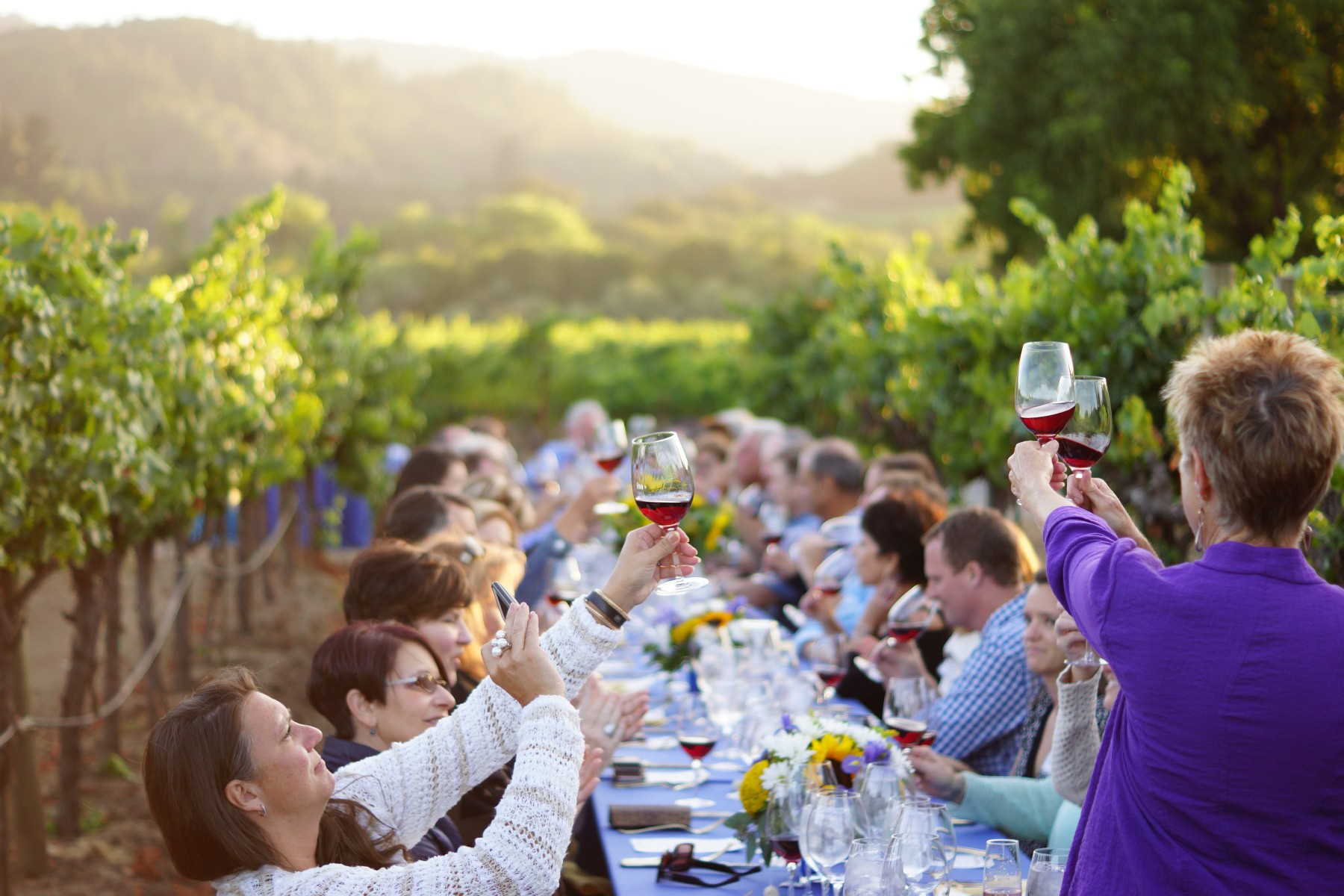Sparkling Moments in Wine
I have been asked lots of questions about owning a winery after spending so many years in the corporate world. Here are some of the stories of my journey into wine that have added sparkling moments to my life.
Raising our Glass to Mike Farrow
Mike Farrow (1943 - 2023)
It is with great sadness that we announce the death of Amista Vineyards co-founder Mike Farrow, who died at the age of 80 in hospice care on December 4, 2023. His wife and Amista co-founder, Vicky shared details of Mike’s health challenges in a blog post in August. Ultimately, he never fully recovered after contracting sepsis from an injury sustained during a fall earlier this year.
We will greatly miss his sense of humor, his warmth, and constant determination to find a way to turn challenges into creative opportunities. He was an inventive home chef and baker who enjoyed wine country living and sharing those simple pleasures with friends. We will always remember him so dapperly dressed in his tuxedo and top hat each year at our Sparkling Soirée.
Mike’s wife Vicky, Amista’s CEO, will continue to lead the winery and carry on the spirit of Amista with the help of their dedicated team. She invites those who knew Mike to come by the tasting room anytime to raise a glass in his honor.
It was Mike’s inspiration that led to the founding of Amista Vineyards with Vicky in 2004. The journey actually started in 1994 when he decided to plant 150 vines on their property in Saratoga, California, to solve a landscaping problem. Shortly thereafter, he started dabbling in making wine in their garage. Mike immediately fell in love with the alchemy of turning grapes into wine and sharing this love with others, including the many friends along the way who encouraged Mike and Vicky to found Amista. The winery name, as anyone who’s ever been to the tasting room knows, roughly means “making friends” in Spanish.
Mike retired to “Winemaker Emeritus” with the appointment of Ashley Herzberg as winemaker in 2011. Their friendship and collaboration over the years resulted in the expansion of Amista’s wine program, notably the planting of additional Rhône varietals and the creation of Mike’s favorite wine, a blend of Grenache, Syrah and Mourvèdre, which they named Tres. Ashley and Vicky ultimately persuaded Mike that they should launch what has become a growing portfolio of estate sparkling wines.
Next year will mark the 20th anniversary of Amista’s founding. It was always a great source of pride for Mike to have built a business that created friendships and connections, including helping to nurture career paths for many team members over the years.
Mike was born in 1943 in Boulder, Colorado, as the sixth in a line of eight boys to parents Mason, a chemist and Elizabeth, a teacher. After attending the University of Colorado Boulder and then going on to earn a PhD in chemistry from Oklahoma State University, he performed research and taught at the University of Utah, and then joined IBM as a research chemist. While at IBM he met Vicky, and they were married in Boulder in 1983. Mike is survived by his wife, his brothers Joe, Bob, and Tom, brother-in-law Chuck Goudge and many nieces and nephews, and his faithful shelties Torin and Dylan.
A celebration of Mike’s life is planned for the spring, and his legacy will be honored throughout 2024 as part of our 20th anniversary celebrations. We will share more details early next year, in the meantime, please come by for a special pour of Tres in his honor.
Cheers to you Mike, we tip our hats to you!
- Vicky and the Amista Team
Mike and Vicky have been longtime supporters of Sonoma County’s Career Technical Education Foundation. In lieu of flowers, donations can be made to support the foundation’s work to provide hands-on, career-connected learning opportunities to local students at https://ctesonomacounty.org/support-us/
The True Meaning of Amista
What I Discovered at the Vineyard Dinner

Friendship and Gratitude
Dinner in the Vineyard has always been a magical evening. This year was the first time that Mike was not able to join us. We drank a toast to him during dinner with his favorite wine, Tres.
I learned something very important that evening. I tried not to say much about Mike’s situation because it’s a festive occasion and who wants to hear about life’s trials and tribulations? And in fact, after a difficult day, sharing another amazing dinner among the vines with our guests lifted my spirits.
But I learned something more. I was touched when Jerry, a long-time club member, who makes the trip from Rhode Island each year, took the time during the vineyard walk to quietly ask, "How is Mike?" He genuinely wanted to know and didn’t seem to want just a cavalier “he’ll be fine” response.
Later in the evening, his wife Janie told me that they like to know about us and how we’re doing. She said that they feel more a part of the Amista family when they know what’s going on behind the scenes. During the fires, they appreciated our messages describing what was happening and they were relieved to learn we were not in the path of the fire.
So, for those who want to go behind the scenes, I will share more of the details of what our year has been like. Mike is currently in a rehab facility in Santa Rosa awaiting the replacement of his artificial knee. It’s been a rough year for him – a fall in mid-December where he wounded his knee, which led to a stay in the hospital over the holidays followed by two months of recovery at home with a 24/7 caregiver who moved in with us. It was necessary and needed but difficult for two introverts to share our small home with a stranger.
Just when Mike was able to get around on his own again, the wound on the knee became infected and he returned to the hospital at the end of March. He had surgery at Healdsburg Hospital where it was confirmed that the infection had gone to the bone and the artificial knee joint.
The artificial knee was removed and replaced with something called a spacer (basically cement) at UCSF, after which he spent 8 days in ICU to manage the sepsis infection. He was delirious for a few days and over a glass of wine I can tell you some hilarious stories! He returned to Healdsburg Hospital to complete six weeks of IV antibiotics and then transferred to a care facility in Santa Rosa. He is unable to walk because he cannot put any weight on the leg with the spacer.
The process has been much longer and more difficult than either of us imagined. The good news is that he finally has surgery scheduled on September 6 to get a new knee. He continues to get physical therapy while he awaits surgery, but it is limited since he cannot put any weight on the leg. He will return to the care facility for rehab, which will take longer than a typical knee replacement given his loss of muscle strength after spending so many months in bed.
Meanwhile, I have taken over full responsibility for our business – both the winery and vineyard – and our household, plus managing Mike’s healthcare (everyone needs an advocate to navigate the healthcare system) and driving to Santa Rosa to spend time with Mike each day. A bright light is that the dogs can visit him now that Torin has recovered from surgery and Dylan is improving after an injury to his leg during a frisbee run.
I am grateful that we have an incredible team led by Brian and an amazing winemaker and vineyard manager in Ashley and wonderful girlfriends who are there whenever I need something fun to do or a shoulder to cry on. And now I realize that there is a bigger community of Amista friends who are cheering us on. I’ll keep you posted.
With deepest gratitude,
Vicky
5 Surprising Facts About Grenache
All You Need to Know

...plus a delicious Grenache pairing
Why care about Grenache, you might ask? Grenache has gained significant popularity and recognition in the world of wine. Its flavor profile appeals to a wide range of wine lovers and its medium body and medium tannins enable it to pair with a vast array of dishes and cuisines.
I have fallen in love with Grenache since we first added some to our estate vineyards in 2011. But what prompted me to write this post was a recent quote from a wine writer who attended the 40th anniversary celebration of the Dry Creek Valley AVA. Wine writer Mike Dunne proclaimed, “Forty years after federal authorities designated Dry Creek Valley an American Viticultural Area, the appellation’s signature wine has emerged – Grenache!”
That was music to my ears! We added our first Grenache vines despite the widely held opinion that Zinfandel was considered the signature grape in Dry Creek. I didn’t know much about Grenache then, but I knew I loved its medium body and that it was a great match for Mediterranean dishes, such as grilled meats, roasted vegetables, tapas, and even spicy foods – all the foods I love.
Pork tenderloin garnished with a raspberry balsamic sauce goes beautifully with Grenache. Add crispy smashed potatoes and sauteed spinach for a sensational taste experience.
5 Surprising Facts About Grenache
-
Grenache is the name in France; Garnacha is the name in Spain
-
Today Grenache/Garnacha is the 7th most planted grape in the world (5th among reds)
-
Grenache is one of the varieties in the renowned wines of the Châteauneuf-du-Pape AOC and has first billing in the trio of grapes that make up GSM blends (Grenache, Syrah, Mourvèdre)
-
Although often associated with France, it is widely agreed that Garnacha originated in Spain
-
Grenache is now referred to as a Rhône varietal, the world over
3 Interesting Tidbits about Grenache at Amista
- Today Grenache makes up 30% of the planted acres on our Morningsong estate vineyards
- Amista crafts the only Sparkling Grenache north of the Bay Bridge in California
- Grenache is used in seven of our Amista wines
Garnacha or Grenache?
Garnacha and Grenache are the same grape variety, known by different names in different regions. "Garnacha" is the Spanish name for the grape, while "Grenache" is the French name. The grape is believed to have originated in the region of Aragon in northeastern Spain.
While the grape variety itself is the same, there can be stylistic differences in the wines produced from Grenache depending on the terroir and winemaking techniques used in different regions. For example, Garnacha wines from Spain, particularly from regions like Priorat and Rioja, often exhibit a ripe, fruit-forward character with a touch of spiciness. Grenache wines from France, particularly from the southern Rhône Valley and Châteauneuf-du-Pape, can be more complex, showcasing a range of flavors including red and dark fruits, herbs, and floral notes.
A Widely Planted Wine Grape Variety
Although not as widely planted as Cabernet Sauvignon, Grenache/Garnacha is the 7th most planted grape in the world. Here are the top ten as of 2020 according to OIV (International Organisation of Vine and Wine).
Top grape varieties by planted hectares
1. Cabernet Sauvignon, 840,000 acres (340,000 hectares)
2. Merlot, 657,300 acres (266,000 hectares)
3. Tempranillo, 570,800 acres (231,000 hectares)
4. Airén, 538 700 acres (218 000 hectares)
5. Chardonnay, 518,900 acres (211,000 hectares)
6. Syrah, 470 000 acres (190,000 hectares)
7. Grenache Noir, 402,780 acres (163,000 hectares)
8. Sauvignon Blanc, 299 000 acres (121,000 hectares)
9. Pinot Noir, 285,000 acres (115,000 hectares)
10. Trebbiano Toscano / Ugni Blanc, 274,300 acres (111,000 hectares)
Grenache Plays a Starring Role in Châteauneuf-du-Pape
Grenache is one of the stars in the production of Châteauneuf-du-Pape wines and GSM blends. Châteauneuf-du-Pape is a renowned wine appellation located in the southern Rhône region of France. It is known for producing rich, complex, and full-bodied red wines that are highly sought after by wine enthusiasts around the world.
In Châteauneuf-du-Pape, Grenache is the dominant grape variety and is often the star of the blends. It thrives in the region's warm and sunny climate, where it can fully ripen and develop its characteristic flavors and aromas. It is accompanied by other varieties to create a harmonious and balanced wine. The most common blend, known as a GSM blend, consists of Grenache, Syrah, and Mourvèdre. Each variety brings its own unique characteristics to the blend, resulting in a wine with layers of flavors and a complex profile. The combination showcases a balance between fruitiness, spiciness, and structure. The wines are often full-bodied, with a silky texture, well-integrated tannins, and a long, lingering finish.
The Rhône Variety that Originated in Spain…or Italy
The origins of the Garnacha grape variety, also known as Grenache, have been the subject of some controversy and debate among wine experts and historians. While it is widely accepted that the Garnacha grape has Mediterranean roots, the specific location of its origin is still uncertain.
There are several theories regarding the origin of Garnacha. One theory suggests that Garnacha originated in the region of Aragon in northeastern Spain, where it has thrived for centuries, and it is home to some of the oldest Garnacha vineyards.
Another theory suggests that the grape may have originated in the region of Sardinia, Italy. Proponents of this theory point to genetic similarities between Sardinian grapes and Garnacha, as well as historical records that indicate the presence of Garnacha in Sardinia before it became widely established in Spain.
Grapevine cultivation and trade have taken place across the Mediterranean for thousands of years, making it difficult to pinpoint the exact origin of many grape varieties. Genetic studies have shed some light on the relationships between different grape varieties, but they have not definitively settled the debate about Garnacha's precise origin.
Today Grenache is Known as a Rhône Variety
Ironically today Grenache is known as a Rhône variety. This is due to its historical and significant cultivation in the Rhône Valley of southern France. The Rhône Valley is renowned for its production of red wines, and Grenache has been growing there for centuries. I wonder if it also due to the fame of Châteauneuf-du-Pape, which has no such rival in either Spain or Italy.
Still Thirsty?
If you want to learn more about Grenache, here is a curated list of resources.

